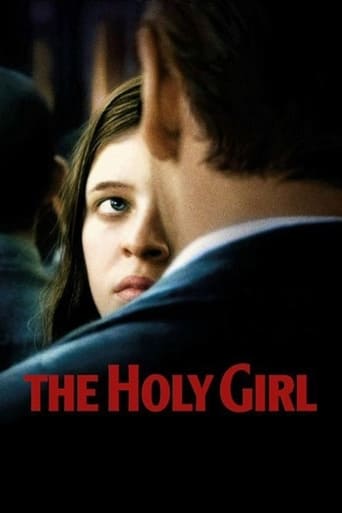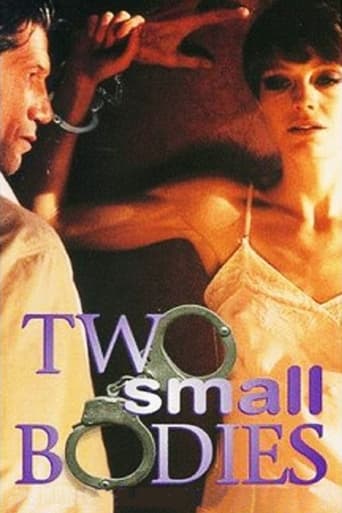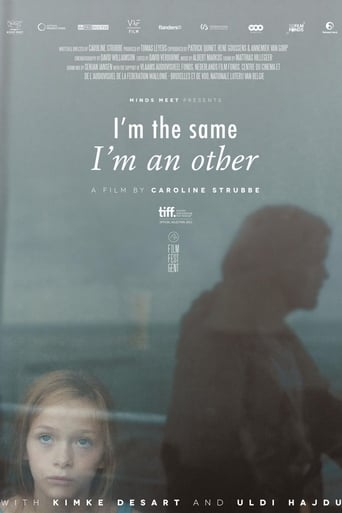

The Holy Girl (2005)
Amalia is an adolescent girl who is caught in the throes of her emerging sexuality and her deeply held passion for her Catholic faith. These two drives mingle when the visiting Dr. Jano takes advantage of a crowd to get inappropriately close to the girl. Repulsed by him but inspired by an inner burning, Amalia decides it is her God-given mission to save the doctor from his behavior, and she begins to stalk Dr. Jano, becoming a most unusual voyeur.
Watch Trailer
Cast


Similar titles
Reviews
It's really hard to enjoy a movie in which nine out of ten characters speak so softly, whispering and grumbling without any sense. I cannot be engaged in a story built exclusively with environmental and symbolic elements and no suspense at all. I do not want to listen anything about the same old debate concerning catholic education and sexual repression (may be 20 or 30 years ago). I suspect this movie is out of season and out of Martel's range. The '60 and '70 were really good but I am not interested in remakes. Despite the above listed complains, I think Martel is talented but may be she still has to find her own voice. I liked "La Ciénaga", the other Lucrecia Martel's effort. It was less pretentious and more entertaining. In summary: this is a boring, pointless, old-fashioned film. I have watched this kind of story before, better written and executed by many directors, v.g.: Luis Buñuel, Carlos Saura and Peter Weir (Please take a look at "Picnic at the hanging rocks") only to name three of them. All in all it deserves a 3/10.
This film received such critical raves, that I decided to rent it on DVD. What a huge mistake. This isn't even mediocre...it's horrible. The first hour of the picture wasn't even necessary. The "story" (and I use that term loosely) takes shape in the last 45 minutes or so. And then I waited for the ending to possibly make sense of this crap and they just roll credits?! Here's some more good adjectives to describe this film: excruciating, over-rated, and pretentious. One of the worst movies of 2005, and knowing how bad 2005 was, that's saying a lot. The only thing that makes me feel better is seeing other User Comments on IMDb ripping into this film as well.
More admirable than attractive is Lucrecia Martel's "The Holy Girl" even at this time I am feeling a steady amount of ambivalence toward this maddeningly beautiful film. Is this kind of paradoxical relationship even possible? Even the proverbial sinner in his love/hate toward expiation seems dubious.The film follows Amalia and her friend Josefina's exploits as they navigate their way through a summer of adolescence. Sanctimonious doesn't even begin to describe them indeed, Amalia is wanting to screw a man she's trying to "save" while Josefina regards her Catholic school teacher with disdain due to the good teacher's sexual adventures even though Josefina herself takes it up the arse from her horny boyfriend. This shopworn irony regarding the duality and dialectical impulses in hormonal, affectedly pious people grows wearisome on the attention span.Okay, but I used the adjective "beautiful" earlier. And it most certainly is from a logistical standpoint. The DP composed seemingly interminable, achingly gorgeous shots of the action. He had no qualms about not using deep-focus photography (in which everything in the frame is in focus). This style harks back to the old American B&W's in which they were not afraid to focus on only one piece of the frame while leaving the rest in a blurry discombobulation. A power erupts from the screen the more pronounced these shots are. However, it must be said, the steady frequency of all this becomes stultifying to an annoying degree like chocolate in endless supply, it becomes too much of a good thing.This cloying film would have been great if it didn't try so hard to be a great film. Art house flicks mostly subscribe to an overly snobby and abundantly complex ideological schema. Is a show-off praiseworthy? Not in this case.
The combination of budding adolescent sexuality and Catholic Sunday School sermonizing leads to confusion and trouble in Lucrecia Martel's remarkable second film The Holy Girl. Similar in style to Alain Cavalier's masterful Thérése, another film about religious fervor, The Holy Girl is an extremely intimate series of minimalist vignettes in which the story unfolds in glimpses and whispered conversations, in "a slow reverie of quick moments". As in Thérése, there is no approval or disapproval of behavior, only a snapshot of events that the viewer is left to interpret -- and it can be a challenge.Set in La Salta, the same small Northern Argentine town as Martel's first feature La Ciénaga, the film takes place at a run down hotel that is hosting a medical convention of ear, nose, and throat doctors. The scene is a constant flux of people and movement and it is difficult at first to sort out the characters. Amalia (Maria Alché) is the sixteen-year old daughter of the hotel's manager Helena (Mercedes Moran) who is recently divorced and lives with her brother Freddy (Alejandro Urdapilleta). Helena suffers from an inner ear problem that is reflected in a discordant ringing noise that affects her relationship with the world around her.As the film opens, Inés (Mia Maestro), a young Catholic teacher leads a group of girls in choir practice. "What is it, Lord, you want of me?" she sings. Overcome with emotion, tears well up in her eyes but Amalia and her friend Josefina (Julieta Zylberberg) merely whisper to each other about the teacher's alleged love affairs. The talk in class is about the student's "mission" and how they can recognize the signs that point to God's calling. Amalia thinks she sees a sign when a doctor attending the conference, Dr. Jano (Carlos Belloso) goes in for some sexual touching while she stands in a group listening to a performance on the Theremin, an instrument that is not touched, but is played by disturbing the surrounding air (perhaps the way adults ought to deal with adolescents).The character's motivations are complex and defy easy categorizing. Jano is a family man with children but seems driven by sexual longings. Helena, still seething that her ex-husband has just fathered twins by his new wife, is attracted to Jano but her advances are not reciprocated and her relationship with Freddy has a hint of more than brotherly love. Josefina teases her young cousin but holds back from committing herself, yet fully engages in kissing with Amalia, though what it means to them is uncertain. Amalia thinks that her mission is to save Dr. Jano and seductively follows him around the hotel, even entering his room when he is not there. At first not relating Amalia's stalking to the incident in the crowd, Jano becomes fearful that his medical career will be jeopardized when he discovers her identity, but the die is cast and Amalia's casual relating the incident to Josefina leads to unintended results.The Holy Girl is elusive and somewhat disorienting, yet it remains an extraordinary achievement, full of intensity and crackling tension, true to the way people act when they are dealing with feelings bubbling beneath the surface. The girls live in their own little world, oblivious to the havoc they have unleashed and it is Martel's brilliant direction that allows us to enter that world, and it is not always comfortable. What happens in the film may be inappropriate but it never seems perverse. We expect the characters to be either heroes or villains but Martel sees them only as flawed human beings. Like the knowing half-smile etched on Amalia's face, her universe is imbued with a mystery that simply observes rather than evaluates. If the ending does not provide us with immediate gratification, it may be because it respects that mystery.














